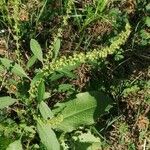Herbs annual, rarely biennial. Stems erect, 30-70 cm tall, branched from base, grooved; branches ascending to nearly divaricate, glabrous. Lower leaves: petiole 3-5 cm; leaf blade oblong to narrowly elliptic, 4-12 × 1.5-3 cm, both surfaces glabrous, or papillose along veins below, base rounded, truncate, or subcordate, margin slightly undulate, apex obtuse or acute; cauline leaves smaller; ocrea fugacious, membranous. Inflorescence racemose, several racemes aggregated and panicle-like. Flowers bisexual. Pedicel articulate below middle (in proximal third). Outer tepals elliptic, ca. 2 mm; inner tepals enlarged in fruit; valves triangular-ovate, 4-5 × 2.5-3 mm, all valves with tubercles 1.5-2 mm (in some infraspecific taxa of R. dentatus only 1 or 2 valves with tubercles), conspicuously net veined, base rounded, each margin with 2-4 teeth, apex acute to subacute; teeth 1.5-2 mm. Achenes yellow-brown, shiny, ovoid, sharply trigonous, 2-2.5 mm, base narrow, apex acute. Fl. May-Jun, fr. Jun-Jul. 2n = 40.
A stout annual (? also biennial), glabrous herb, 20–70 cm. tall.. Stems often branched.. Basal leaves ovate-oblong, often rather narrow, up to 18 × 4 cm., flat or crisped along the edges, apically obtuse to subacute, basally truncate or more rarely subcordate; cauline leaves becoming progressively narrower and shorter, the uppermost sublinear.. Petioles long, but usually shorter than the lamina.. Inflorescence an open, rather stout panicle, leafy or not.. Inner tepals varying from ovate-triangular to deltoid, 3.5–5 × 2–3 mm., equally or unequally tubercled, the margin entire or more usually armed with straight or slightly arcuate teeth (occasionally slightly hooked) which in length are less than or exceed the width of the tepal.. Nut 2–2.75 × 1.5 mm., brown, acutely trigonous.
An erect annual herb. It grows to about 70 cm high. The lower leaves are stalked. They are 3-20 cm long by 0.6-5 cm wide. They are oblong and rounded or heart shaped at the base. The upper leaves are smaller. The flowers are greenish yellow. The occur in distinct leafy rings in the axils of leaves. The fruit is a nut. It is 3 sided.


